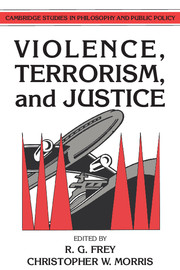Book contents
- Frontmatter
- Contents
- List of contributors
- Preface
- 1 Violence, terrorism, and justice
- 2 What purposes can “international terrorism” serve?
- 3 Violent demonstrations
- 4 Terrorism, rights, and political goals
- 5 The political significance of terrorism
- 6 Terrorism and morality
- 7 Which are the offers you can't refuse?
- 8 Making exceptions without abandoning the principle: or how a Kantian might think about terrorism
- 9 State and private; Red and White
- 10 State terrorism
- 11 Nuclear hostages
- 12 Rape as a terrorist institution
4 - Terrorism, rights, and political goals
Published online by Cambridge University Press: 05 June 2012
- Frontmatter
- Contents
- List of contributors
- Preface
- 1 Violence, terrorism, and justice
- 2 What purposes can “international terrorism” serve?
- 3 Violent demonstrations
- 4 Terrorism, rights, and political goals
- 5 The political significance of terrorism
- 6 Terrorism and morality
- 7 Which are the offers you can't refuse?
- 8 Making exceptions without abandoning the principle: or how a Kantian might think about terrorism
- 9 State and private; Red and White
- 10 State terrorism
- 11 Nuclear hostages
- 12 Rape as a terrorist institution
Summary
USAGE AND DEFINITION
An examination of usage is particularly unhelpful in deciding what terrorism is and whether it can be justified. Usage characteristically applies the term to violent acts performed by those of whose positions and goals the speaker disapproves, and fails to apply it to similar acts by those with whose positions and goals the speaker identifies. And usage much more frequently applies the term to those who threaten established conditions and governments than to those using similar kinds of violence to uphold them. There is a tendency to equate terrorism with the illegal use of violence, but of course the questions who can decide what is illegal and on what grounds are often the questions at issue.
Careful analysis can make progress in clarifying the issues surrounding terrorism and in providing a basis for recommended interpretations. We can recognize that drawing distinctions is difficult, and yet agree with Jenny Teichman when she says that “seemingly ambiguous kinds of violence can … be distinguished from one another.” She suggests that “revolutions can be differentiated into the peaceful and the violent. … Civil protest, similarly, can be either peaceful or violent. Guerrilla war is simply small war. Whether riots are crimes or acts of war depends on the intention and the degree of organization of the rioters.” Whether or not one shares her ways of drawing these distinctions, one can agree with her conclusion that such distinctions are possible, and important to make.
- Type
- Chapter
- Information
- Violence, Terrorism, and Justice , pp. 59 - 85Publisher: Cambridge University PressPrint publication year: 1991
- 7
- Cited by



